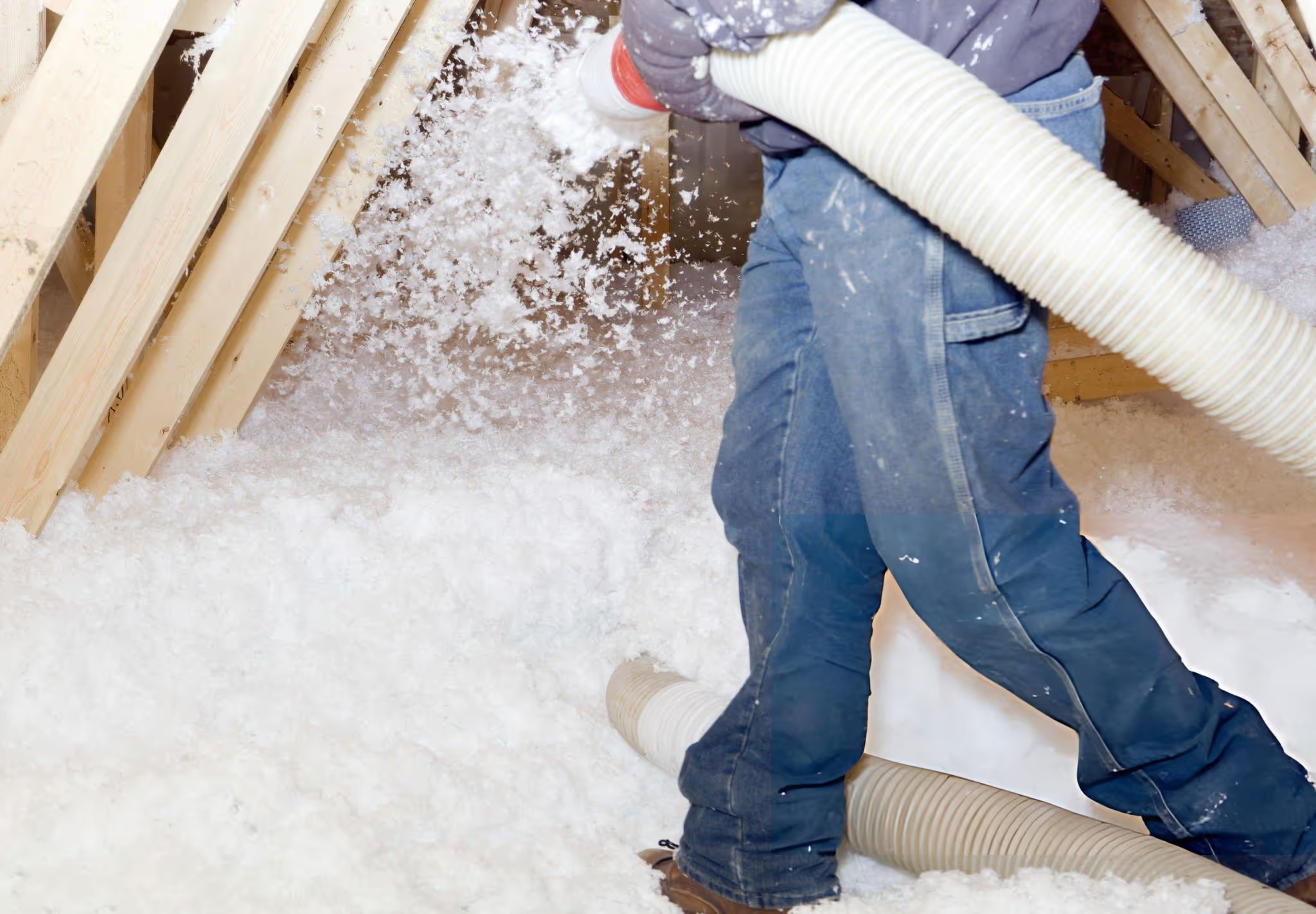Attic blow-in insulation is one of the most effective retrofit measures to improve comfort and reduce energy bills in Denton, TX homes. With hot, humid summers and a wide daily temperature swing in spring and fall, adding properly installed loose-fill insulation to the attic floor reduces heat gain, stabilizes indoor temperatures, and reduces strain on HVAC systems.

Why blow-in insulation is a strong fit for Denton homes
- Hot summers increase roof-to-attic heat transfer; adding depth of insulation reduces cooling load and runtime.
- Pre-install inspection and planning
- Confirm access, locate hazards, and create a plan for air sealing and baffle placement. Identify areas where insulation depth needs to be higher or lower (e.g., around ducts or recessed fixtures).
- Air sealing first (critical step)
- Seal attic-floor penetrations using caulk, spray foam, and weatherstripping at the attic access. Close gaps at top plates, chases, and around HVAC boots and duct transitions. Effective air sealing reduces convective heat transfer and ensures insulation performs as intended.
- Install baffles and protect ventilation paths
- Install rafter vent baffles at soffits to preserve intake ventilation and prevent insulation from blocking airflow. Baffles protect roof sheathing from moisture buildup in humid conditions common to Denton.
- Prepare HVAC and fixtures
- Ensure ducts in the attic are sealed and insulated as needed; cover or protect recessed or non-IC rated fixtures to prevent contact with loose-fill. Mark areas that require lower depth for clearances.
- Blowing operation and quality control
- Use a commercial blower machine and calibrated feed hose. Technicians set feed rates and density for cellulose or fiberglass based on manufacturer specs, blowing method, and target R-value. Depth gauges or rulers are used to achieve consistent thickness across the attic.
- Final inspection and documentation
- Verify uniform coverage, check that ventilation remains unobstructed, and document pre- and post-install depths. Install attic access insulation or cover hatch if needed.
Expected energy savings and payback in Denton, TX
- When air sealing is combined with adding blown-in insulation, many homeowners in hot-humid climates see measurable reductions in cooling and heating energy use. Typical whole-house energy savings vary depending on existing insulation levels and HVAC efficiency; most homeowners realize noticeable reductions in peak cooling runtime and more consistent indoor temperatures.
- Payback periods are influenced by pre-existing insulation, local electricity prices, and how often cooling is used. Homes with very low starting insulation depth generally see faster payback because additional R-value and sealed air leaks reduce cooling demand more significantly.
Comparison: blown-in vs batt, spray foam, and radiant barriers
- Blown-in (fiberglass or cellulose): best for retrofits and filling gaps; fast installation with minimal disruption.
- Fiberglass batts: cheaper for new framing runs but can leave gaps and underperform when not installed perfectly.
- Spray foam (closed-cell/open-cell): high R-per-inch and superior air sealing; ideal when sealing the roof deck or where space is limited, but it is more expensive and typically used selectively.
- Radiant barrier: reduces radiant heat transfer in very hot sunny climates; most effective when combined with adequate bulk insulation and in DFW-area attics with high solar loads.
Typical timelines and what affects job length
- Assessment and quote: usually completed within one inspection visit (1–2 hours).
- Installation: most single-family homes’ attic blow-in installations are completed the same day (half day to full day) depending on attic size, accessibility, and the extent of preparatory air sealing. Larger homes or ones needing significant attic remediation may require more time over multiple days.
Warranty and maintenance considerations
- Installer warranties typically cover workmanship and depth guarantees; material manufacturers may provide performance guidelines but limited product warranties. For cellulose, plan for periodic inspections—settlement can reduce nominal R-value over many years, and dense-pack techniques reduce settling.
- Recommended maintenance: inspect the attic every 3–5 years for signs of settling, moisture intrusion, rodent activity, or blocked ventilation. Top-up additions can restore depth where settling has occurred. Keep attic exhaust fans and vents functioning and HVAC ducts sealed to prolong insulation performance.
Financing and maintenance-plan options
- Denton homeowners commonly use home improvement loans, HVAC/energy-efficiency financing programs, and seasonal financing plans tailored for home performance improvements. Some local utility or state programs may offer rebates or incentives for insulation upgrades—these programs change over time and are worth reviewing when planning a project. Maintenance-plan options often bundle periodic attic inspections with HVAC Tune-Ups to protect both insulation performance and system efficiency.
FAQs
Q: How long does blown-in attic insulation last?
A: Properly installed blown-in fiberglass or dense-packed cellulose can last decades; periodic inspections are recommended to check for settling, moisture, or pest issues.
Q: Will blown-in insulation cause moisture problems in my Denton attic?
A: When combined with correct ventilation and attention to roof/attic leaks, blow-in insulation does not cause moisture problems. Proper air sealing and baffles are key in Denton’s humid climate.
Q: Can blown-in insulation be installed over existing insulation?
A: Yes. Technicians typically measure existing depth and add blown-in material to reach the target R-value, ensuring even coverage and taking care to avoid compressing the existing material.
Q: Do I need to move stored items out of the attic?
A: It's recommended to clear storage from areas where insulation will be added. Technicians will advise on safe zones and protect items left near access points.
Q: How much disruption should I expect during installation?
A: Installation is largely confined to the attic. Expect some noise from the blower equipment and entry/exit activity, but most projects are completed in a single day for typical homes.
Q: Is cellulose treated for pests and fire?
A: Yes, cellulose used for attic insulation is treated with fire-retardant and pest-resistant additives; installers follow product safety guidelines and local code for clearances around fixtures.

Flexible Financing Options
Explore our range of flexible financing options designed to suit your needs and budget.













